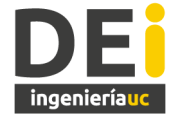Publicaciones
A continuación te presentamos nuestras publicaciones científicas asociadas a la ECA
In recent years, instructional design has become even more challenging for teaching staff members in higher education institutions. If instructional design causes student overload, it could lead to superficial learning and decreased student well-being. A strategy to avoid overload is reflecting upon the effectiveness of teaching practices in terms of time-on-task. This article presents a Work-In-Progress conducted to provide teachers with a dashboard to visualize student self-reports of time-on-task regarding subject activities. A questionnaire was applied to 15 instructors during a set trial period to evaluate the perceived usability and usefulness of the dashboard. Preliminary findings reveal that the dashboard helped instructors became aware about the number of hours spent outside of class time. Furthermore, data visualizations of time-on-task evidence enabled them to redesign subject activities. Currently, the dashboard has been adopted by 106 engineering instructors. Future work involves the development of a framework to incorporate user-based improvements.
Due to the transition to online education, higher education students require more support to self-regulate their learning and their time management. This paper presents a work-in-progress conducted to design and implement web-based weekly timesheets to collect students’ self-reports of time-on-task regarding different course activities. During the second semester of 2020, 5,221 students received the web-based weekly timesheets, and 3,131 voluntarily self-reported time-on-task throughout 16 weeks. At the end of the semester, a questionnaire was applied to evaluate the perceived usability and usefulness of this web-based application. This questionnaire was voluntarily answered by 1,200 students; 92% perceived that the timesheets were easy to use and 75% that it was useful for monitoring their academic workload. In their comments, students reveal that the tool allowed them to become aware of the number of hours spent outside of class time. Considering their suggestions, future work involves incorporating a student-facing dashboard in this web-based application.
https://link.springer.com/chapter/10.1007/978-3-030-86436-1_49
Curriculum Analytics (CA) emerged as a sub-field of Learning Analytics, aiming to use large amounts of educational data to drive curriculum decision-making and program improvement. However, it is still an open question how the use of CA tools impacts student learning and program quality. To advance this field, this paper describes the lessons learned from having designed and implemented a CA tool to help managers and teaching staff reflect on curriculum and teaching practices. This CA tool was developed under a design-based research approach called The Integrative Learning Design Framework. We implemented a two-cycle building-testing structure to evaluate the perceived usefulness and usability of this tool. The first cycle consisted of designing a first version of the tool and evaluating its use throughout a case study involving 5 managers and 124 teaching staff members who participated in a 3-year continuous improvement process in one Latin American university. The second cycle consisted of redesigning the tool according to the lessons learned during the first cycle and evaluating its use throughout workshops with 16 managers and 9 teaching staff members in two Latin American universities. Findings indicate that the CA tool helped teachers collect a greater number and variety of evidence regarding students’ attainment of competencies, allowing staff to be more aware of the learning situation of their students when redesigning course assessment methods and course sequences. Currently, this CA tool is being used by 20 Latin American universities, guiding curriculum renewal strategies beyond the current global pandemic.
https://link.springer.com/article/10.1007/s12528-022-09315-4
